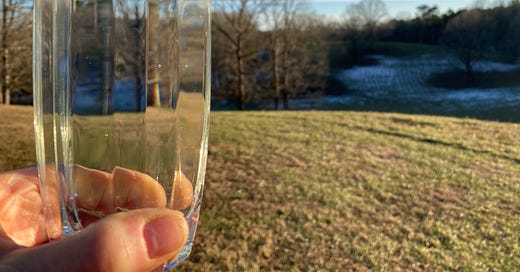Last week, a man named John came to put a new sink in my kitchen. I’ve stuck with the basic model since the house was built: a big farmhouse sink made of cast iron with white enamel, which takes about fifteen years to wear through. The new sink is my third, right on time. The old one got so much use that a damp crack opened behind it where tiny greens began to grow. I found them cheerful, but when the younger generation came to visit, they found them alarming and scrubbed them to death.
When John got ready to go, I asked if he wanted a glass of water, and he did. I filled one from the tap—no ice cube—which he drank straight down. Then he set the glass on the counter and said, “That’s good water.”
I’ve heard that before and always feel a little prideful, though the quality of the water has nothing to do with me. It comes from a shallow well you can see from my kitchen window, down in a valley between two hills. Most of my neighbors have deep-drilled wells, which are supposed to be safer and more reliable, but their water doesn’t taste like mine. Mine comes from a water table aquifer that feeds two natural springs further down the valley. When it rains hard, we have plenty of water. When there’s no rain for weeks, we ration. Drinking water comes first, baths happen at a sink, and washing clothes can wait. We won’t talk about toilets, except to give thanks for the great outdoors.
During the last long drought, my husband Ed and I talked about drilling a deep well so we could have all the water we wanted. After finding out how much that would cost, how much earth would be displaced in the digging, and how many tries it might take to find a deep aquifer, we decided to live with the water we had. The land didn’t need any more puncture wounds. The built-in rationing made sense. We had good water, and our intimacy with it was worth the inconvenience.
People talk about the terroir of a good wine—the meeting point of soil, topography, and weather that make each year’s vintage different from the last. When experts sample a fine wine, they come to it with all their senses, taking in its color, body, and aroma before taking it into their mouths and letting it play on their tongues. Then they say things like, “notes of pear and tarragon, with a hint of buttered toast and caramel” or “jammy blend of stone-fruits with a touch of pepper and a bit of cigar box on the finish.” I could read these things all day.
The difference between a good bottle of wine from the Russian River Valley and a glass of water from my tap is that the water and I live together. We depend on the same terroir, which produces plenty one year and barely enough the next. When the land is thirsty, so am I. When it is quenched, I am too. What happens to the land for miles around goes straight into my body, since my water lies right below. When I drink a glass of it on a cold day in mid-January, I taste melted snow and pine cones, with a hint of last year’s mown meadow and a strong finish of sunlight on warm stone.
That’s good water.





Your writing always seems to make me feel like I’m outdoors. Hint of ponderosa, tangy notes of moss, with a smooth robin wing finish. Thank you, Barbara.
Like the good water you wrote about, your words are like good water soothing my soul. I appreciate you and your timely thoughts so much. Thank you.